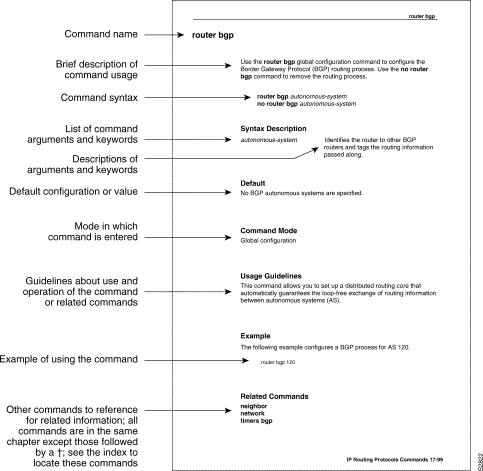This section discusses the objectives, audience, organization, and conventions of the Router Products Command Reference publication.
This publication provides an in-depth description of the commands necessary for configuring and maintaining your router. It describes tasks only in the context of using a particular command; it does not describe how the tasks interrelate or provide comprehensive configuration examples.You can use this publication as a standalone reference manual or in conjunction with the Router Products Configuration Guide. Not all of the debug commands are included in this publication, but you can find all of them in the Debug Command Reference publication.
Use the Router Products Command Reference to do the following:
- Look up detailed information on command usage
- See what commands can be used in conjunction with a particular command
This publication is intended as a standalone document for experienced network administrators who will be configuring and maintaining routers and would like to reference commands. For less-experienced users who need to understand the tasks as well as the commands, it is intended as a companion guide to the Router Products Configuration Guide.
This publication is divided into six main parts. Each part comprises chapters describing related tasks or functions. The organization of parts and chapters in this publication matches the organization of parts and chapters in the Router Products Configuration Guide, except that this document contains appendixes. The parts in this publication are as follows:
- Part 1, "Product Introduction," contains an overview of the router and command descriptions for the system user interface and command parser.
- Part 2, "System and Interface Configuration and Management," describes the commands pertaining to booting, terminal sessions and modem lines, system management, and system interfaces.
- Part 3, "Wide-Area Networking," describes the tasks pertaining to ATM, DDR, Frame Relay, HDLC, ISDN, LAN emulation (LANE), PPP, SLIP, SMDS, and X.25. The chapters are arranged in alphabetical order for ease of use.
- Part 4, "Routing Protocols," contains chapters that describe the commands used to configure each supported network protocol. These protocols include Apollo Domain, AppleTalk, Banyan VINES, DECnet, IP, ISO CLNS, Novell IPX, and XNS (including Ungermann-Bass and 3Com variations). This part also contains a chapter that discusses commands for IP routing protocols, which include IGRP, Enhanced IGRP, BGP, RIP, OSPF, IS-IS, and ISO-IGRP. The chapters are arranged in alphabetical order for ease of use.
- Part 5, "Bridging," contains chapters that describe the commands used to configure transparent bridging, source-route bridging, source-route transparent (SRT) bridging, and source-route translational bridging (SR/TLB) on our routers/bridges.
- Part 6, "IBM Networking," contains chapters that describe how to configure the SDLC transport and serial tunneling mechanisms in an IBM local-area network (LAN). Also included are the tasks for configuring the local acknowledgment feature, managing your source-route bridges with LAN Network Manager, and configuring SDLLC and QLLC conversion, our IBM network protocol translation features. Part 6 also contains chapters that describe how to configure SNA downstream physical unit (DSPU) support and SNA Frame Relay access support, and Advanced Peer-to-Peer Networking (APPN), which provides support for client/server applications and offers more dynamics than traditional hierarchical SNA. Also covered in this part is data link switching plus (DLSw+), an SNA-over-IP routing standard that integrates SNA and LAN internetworks. The IBM Channel Attach chapter describes how to configure a Channel Interface Processor (CIP).
The appendixes contain a list of references and recommended reading, Ethernet type codes, regular expressions, a table of the ASCII character set, switching information, and a description of IOS 11.0 features supported by specific router platforms.
Software and hardware documentation uses the following conventions:
- The caret character (^) represents the Control key.
- For example, the key combinations ^D and Ctrl-D are equivalent: Both mean hold down the Control key while you press the D key. Keys are indicated in capitals, but are not case sensitive.
- A string is defined as a nonquoted set of characters.
- For example, when setting an SNMP community string to "public," do not use quotation marks around the string; otherwise, the string will include the quotation marks.
Command descriptions use these conventions:
- Vertical bars ( | ) separate alternative, mutually exclusive, elements.
- Square brackets ([ ]) indicate optional elements.
- Braces ({ }) indicate a required choice.
- Braces within square brackets ([{ }]) indicate a required choice within an optional element.
- Boldface indicates commands and keywords that are entered literally as shown.
- Italics indicate arguments for which you supply values; in contexts that do not allow italics, arguments are enclosed in angle brackets (< >).
Examples use these conventions:
- Examples that contain system prompts denote interactive sessions, indicating that the user enters commands at the prompt. The system prompt indicates the current command mode. For example, the prompt
router(config)# indicates global configuration mode.
- Terminal sessions and information the system displays are in
screen font.
- Information you enter is in
boldface screen font.
- Nonprinting characters, such as passwords, are in angle brackets (< >).
- Default responses to system prompts are in square brackets ([ ]).
- Exclamation points (!) at the beginning of a line indicate a comment line. They are also displayed by the router for certain processes.
 | Caution Means reader be careful. In this situation, you might do something that could result in equipment damage or loss of data. |
Note Means
reader take note. Notes contain helpful suggestions or references to materials not contained in this manual.
The following illustration explains the fields of a typical command reference page.



